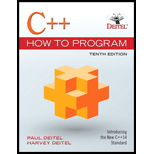
Concept explainers
(Tax Plan Alternatives: The "Fair' Tax") There are many (often controversial) to make taxation fairer. "Check out the Fair Tax initiative in the United States at www.fairtax.org.
Research how the proposed Fair-I-ax works. One suggestion is to eliminate income taxes and most other taxes in favor of a consumption tax on all products and services that you buy. Some Fair- Tax opponents question the 23% figure and say that because of the way the tax is calculated, it would be more accurate to say the rate is 30% check this carefully. Write a
Want to see the full answer?
Check out a sample textbook solution
Chapter 5 Solutions
C++ How To Program Plus Mylab Programming With Pearson Etext -- Access Card Package (10th Edition)
- using the fill function in python fill elements of a list with a given value def fill(data, value) :arrow_forwardComplete the following program that creates a duplicate version of a list but with the elements stored in reverse order from the original. origValues = [1, 5, 65, 30, 200, 46, 48, 5, 14, 30] newValues = []arrow_forwardUsing python code Find maximum value of a list: values = [2, 45, 3, 25, 6, 8, 5, 100, 104] Then, remove that maximum value from the listarrow_forward
- How to modify the code below so that it prints all possitive values in a list that is separated by commas? values = [1, -2, 3, 4] for i in range(len(values)) : if i > 0 : print(" | ", end="") print(values[i], end="")print()arrow_forwardusiing python remove all negative values from a list of values values = [34, -8, -5, 4, 6, 7]arrow_forwardUsing python, remove highes and lowest score and then sum the remaining 6 scores: scores = [1.4, 5.5, 4.7, 2.0, 6.3, 7.5, 2.6, 5.3, 8.1] totalScore= print("Score = %5.2f" % totalScorearrow_forward
- What are quantitative and qualitative data? Describe an example of a use case and visual representation for qualitative data and one for quantitative data from your organization.arrow_forward1. Checksum. Assuming the following IP header lacking checksum: 01000101.00000000.11000011.00101010. 00000000.00000000.00000000.00000000. 10000000.00000000.00000000.00000000. <- checksum 01100011.11011001.00000000.00000001. 10000000.00000000.00000000.00000010 Compute its checksumarrow_forwardI would like to know the features of BranchCache, Metadata, and LPR Port Monitorarrow_forward
- Please answer the JAVA OOP questions below: How do arrays of objects differ from arrays of primitive types? Why and when would you use an array of objects? What are the different ways to initialize an array of objects? What is a static variable in Java? How does its scope differ from instance variables? When should you use static variables? Provide examples where static variables are beneficial over instance variables. What is the difference between static and non-static methods in the Data Definition Class? What are the benefits of using static methods?arrow_forwardAssume you are a loyal member of Costco. You have been expecting your membership reward from the company, and you just received a text message on your mobile phone. The message appears to be from Costco: Costco - Your 3% return is ready: costco.wholesaledividend.com Before clicking the link in the message, you consider whether this is genuinely from Costco or a phishing attack on you. How can you tell? If it is a phishing attack, what mechanism was most likely used to send the message to you? What actions can you take if you are not sure whether it is a genuine message from Costco? What actions can you take if you are sure this is a phishing attack?arrow_forwardRSA and Diffie-Hellman are important algorithms in public-key cryptography. What are the differences between the two? Assume you intercept the ciphertext C = 105 sent to a user whose public key is e = 7, n = 403. Explain in detail how you will find the private key of the user and crack the ciphertext. What is the plaintext M?arrow_forward
 Operations Research : Applications and AlgorithmsComputer ScienceISBN:9780534380588Author:Wayne L. WinstonPublisher:Brooks Cole
Operations Research : Applications and AlgorithmsComputer ScienceISBN:9780534380588Author:Wayne L. WinstonPublisher:Brooks Cole C++ for Engineers and ScientistsComputer ScienceISBN:9781133187844Author:Bronson, Gary J.Publisher:Course Technology Ptr
C++ for Engineers and ScientistsComputer ScienceISBN:9781133187844Author:Bronson, Gary J.Publisher:Course Technology Ptr C++ Programming: From Problem Analysis to Program...Computer ScienceISBN:9781337102087Author:D. S. MalikPublisher:Cengage Learning
C++ Programming: From Problem Analysis to Program...Computer ScienceISBN:9781337102087Author:D. S. MalikPublisher:Cengage Learning New Perspectives on HTML5, CSS3, and JavaScriptComputer ScienceISBN:9781305503922Author:Patrick M. CareyPublisher:Cengage Learning
New Perspectives on HTML5, CSS3, and JavaScriptComputer ScienceISBN:9781305503922Author:Patrick M. CareyPublisher:Cengage Learning Programming with Microsoft Visual Basic 2017Computer ScienceISBN:9781337102124Author:Diane ZakPublisher:Cengage Learning
Programming with Microsoft Visual Basic 2017Computer ScienceISBN:9781337102124Author:Diane ZakPublisher:Cengage Learning EBK JAVA PROGRAMMINGComputer ScienceISBN:9781337671385Author:FARRELLPublisher:CENGAGE LEARNING - CONSIGNMENT
EBK JAVA PROGRAMMINGComputer ScienceISBN:9781337671385Author:FARRELLPublisher:CENGAGE LEARNING - CONSIGNMENT





